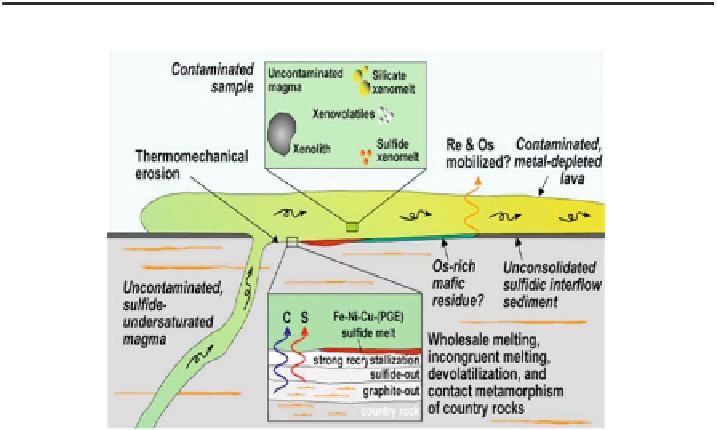Geology Reference
In-Depth Information
Table 3.2 Comparison of the physical properties of komatiites and basalts
Komatiite
Basalt
MgO (wt.%)
30
8
Temperature (
C)
1600
1200
Viscosity (poises)
5
100
10
4
to 10
5
Reynolds number (turbulent flow when Re
500)
500
>
Fig. 3.10 The ore-forming process at Kambalda
higher temperature (up to 1,600
C), and has a much lower viscosity, than the basalt.
The Reynold's Number is a fluid-dynamic parameter that describes whether the
flowage of a liquid is linear or turbulent. A threshold of 500 separates the two flow
regimes. The value for a 10 m thick komatiite flow is around 10
5
, well above the
threshold. The komatiite lava therefore flows turbulently and the heat from this ultra
high-temperature lava is transferred directly to the floor rocks (Fig.
3.10
). The
consequence is that the floor rocks melt and are assimilated into the komatiite lava.
At Kambalda, the floor rocks are sulfide (pyrite)-rich cherty sediments which, when
assimilated into the komatiite, change the composition of the magma. This contam-
ination simultaneously boosts the S content and decreases sulfide solubility and this
leads to the segregation of immiscible sulfide liquid. Because the komatiite has a
high Ni content, and because Ni is a chalcophile element, the sulfide becomes rich
in Ni and other chalcophile elements like Cu and the PGE; because the sulfide is
denser than the silicate liquid, it settles to the base of the flow to form the ore
deposit. The process is illustrated in Fig.
3.10
.
Basaltic liquids are cooler andmore viscous than komatiites and their lowReynold's
number means that their flowage was laminar. For this reason they are rarely capable of
assimilating their floor rocks. Extra sulfur cannot readily be incorporated from external
sources and a separate sulfide liquid forms only at late stage of crystallization when



Search WWH ::

Custom Search